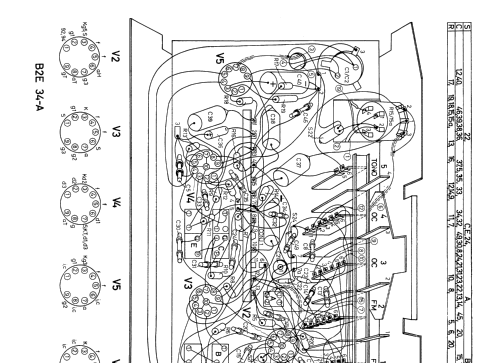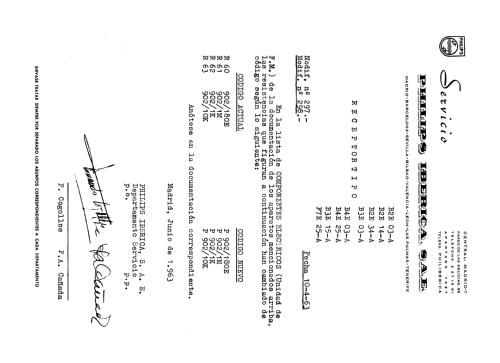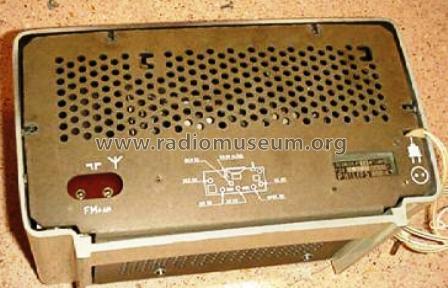- Country
- Spain
- Manufacturer / Brand
- Philips Ibérica, COPRESA, Compañía de Productos Electrónicos, Miniwatt tubes, SELEZ; Madrid, Barcelona
- Year
- 1963 ?
- Category
- Broadcast Receiver - or past WW2 Tuner
- Radiomuseum.org ID
- 81363
Click on the schematic thumbnail to request the schematic as a free document.
- Number of Tubes
- 6
- Main principle
- Superheterodyne (common); ZF/IF 470/10700 kHz; 2 AF stage(s)
- Tuned circuits
- 6 AM circuit(s) 7 FM circuit(s)
- Wave bands
- Broadcast, Short Wave plus FM or UHF.
- Power type and voltage
- Alternating Current supply (AC) / 110-127 Volt
- Loudspeaker
- Permanent Magnet Dynamic (PDyn) Loudspeaker (moving coil) / Ø 10 cm = 3.9 inch
- Material
- Plastics (no bakelite or catalin)
- from Radiomuseum.org
- Model: B2E34A /00F / 00K - Philips Ibérica, COPRESA,
- Shape
- Tablemodel with Push Buttons.
- Dimensions (WHD)
- 301 x 173 x 156 mm / 11.9 x 6.8 x 6.1 inch
- Notes
-
/00F = color Verde (green)
/00K = color Arena (sand)FM = 87,5 - 100 MHz usando módulo AM-FM tipo EB-9159
Alimentación por autotransformador. Mains through autotransformer.
- Net weight (2.2 lb = 1 kg)
- 4 kg / 8 lb 13 oz (8.811 lb)
- Literature/Schematics (1)
- -- Original-techn. papers.
- Author
- Model page created by Juan Antonio Pardo-Alonso. See "Data change" for further contributors.
- Other Models
-
Here you find 633 models, 527 with images and 469 with schematics for wireless sets etc. In French: TSF for Télégraphie sans fil.
All listed radios etc. from Philips Ibérica, COPRESA, Compañía de Productos Electrónicos, Miniwatt tubes, SELEZ; Madrid, Barcelona
Collections
The model is part of the collections of the following members.
Forum contributions about this model: Philips Ibérica,: B2E34A /00F / 00K
Threads: 1 | Posts: 3
Si la Org.lo considera oportuno,creo que la observación que voy a exponer,podria ser de gran utilidad para cualquier miembro que vaya a reparar esta radio:
Como la sintonia se hace a través de varicaps,el acoplamiento entre los émbolos y el tambor del hilo de sintonia,se hace a por medio de una bieleta que encaja en un tope saliente del tambor.
A la hora de montar el chasis sobre el mueble,es MUY IMPORTANTE situar el tambor a mitad de recorrido y controlar entonces que la ranura de la bieleta se introduce correctamente en el tope.Si se descuida este detalle,el conjunto se descontrola y su reparación y puesta a punto,resulta muy engorrosa y laboriosa.
Juan Alvarez Alonso, 06.May.12












































